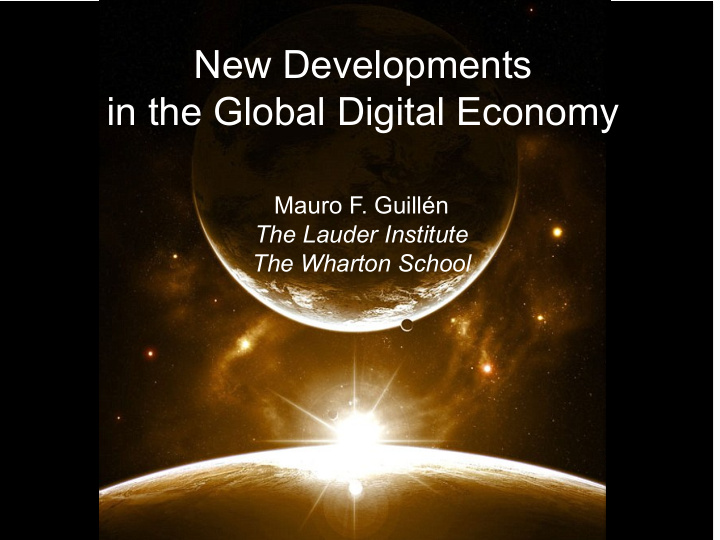



New Developments in the Global Digital Economy Mauro F. Guillén The Lauder Institute The Wharton School
Which country successfully launched a probe into Mars orbit on the first attempt?
How much did it cost? • $74 million. • Interstellar: $165 million. • The Martian: $108 million.
Which event is larger? • Cyber Monday. • Black Friday. • Singles’ Day.
Gambling Revenue •Vegas or Macau? •Vegas: $7 billion. •Macau: $33 billion.
By 2040, which will be the world’s largest middle-class market?
Shares of Global Middle-Class Consumption, 2000-2030 Source: Homi Kharas.
Shares of Global Middle-Class Consumption, 2000-2050 Source: Homi Kharas.
TREND #1: SOCIAL MEDIA USERS (% POPULATION) Source: We Are Social, 2018 Digital Yearbook .
WORLD’S LARGEST CITIES 1960 Source: United Nations Population Division, World Urbanization Prospects, the 2011 Revision.
WORLD’S LARGEST CITIES 1970 Source: United Nations Population Division, World Urbanization Prospects, the 2014 Revision.
WORLD’S LARGEST CITIES 1990 Source: United Nations Population Division, World Urbanization Prospects, the 2014 Revision.
WORLD’S LARGEST CITIES 2014 Source: United Nations Population Division, World Urbanization Prospects, the 2014 Revision.
WORLD’S LARGEST CITIES 2030
TREND #2: AIRBNB DEMOGRAPHICS Source: https://www.bloomberg.com/technology
Wines • What’s the difference between grape juice and wine. • Why is the standard wine bottle 750 ml? • How do you make sparkling wine? • What’s the difference between? – Champagne. – Cava. – Prosecco.
TREND #3: DIGITAL SALES OF WINES Total value CAGR Value per Offtrade Offtrade Online Sales (% total offtrade volume) Country 2016 $bn 2011-16 Liter $ value $bn vol mn l 2011 2012 2013 2014 2015 2016 China 1.7 3.1 6.5 10.6 15.0 19.3 66.5 3.1 14.5 23.7 3,090.1 USA 1.2 1.3 1.4 1.5 1.6 1.8 44.0 2.1 13.9 24.2 2,670.6 France 2.9 3.1 3.3 3.7 4.1 4.3 29.0 0.2 12.2 10.6 1,679.5 UK 6.7 6.8 6.8 8.1 10.1 10.3 20.2 0.1 14.9 12.4 1,124.3 Japan 2.4 2.6 2.9 3.1 3.2 3.3 19.4 1.2 21.9 6.7 567.0 Italy 1.4 1.5 1.7 1.8 2.0 2.0 15.5 0.4 6.7 7.1 1,551.4 Germany 2.2 2.3 2.3 2.7 3.2 3.3 14.5 0.0 7.2 6.8 1,657.1 Canada 0.2 0.2 0.3 0.3 0.3 0.3 9.5 3.5 16.6 6.8 484.7 Australia 6.0 7.0 8.0 9.5 10.5 11.3 6.8 3.2 11.8 3.5 459.9 Russia 0.1 0.1 0.1 0.2 0.2 0.2 5.5 -5.5 6.1 5.1 872.9 Spain 1.0 1.0 1.1 1.2 1.3 1.3 5.2 -0.6 5.4 1.6 465.9 Switzerland 0.6 0.6 0.6 0.6 0.7 0.7 5.0 0.1 18.6 2.8 230.2 Austria 2.5 2.5 2.5 2.6 2.7 2.7 4.3 1.1 16.9 1.0 135.7 Brazil 1.6 1.8 2.1 2.3 2.4 2.5 4.0 -0.4 11.7 2.5 254.9 Greece - - - - - 0.1 3.4 -4.7 11.7 1.0 153.9 Argentina 1.5 1.6 1.7 1.8 1.8 1.9 3.4 6.8 3.4 2.1 834.1 Belgium 6.9 7.1 7.3 7.6 7.8 8.5 3.3 1.1 11.4 1.6 219.2 Sweden 1.4 1.8 2.4 2.3 2.6 2.7 3.2 3.0 14.3 2.2 202.7
LABELS VS. BRANDS
Trend #4: Sales of e-Books in the US. http://newsroom.publishers.org/book-publishing-annual-statshot-survey-reveals-religious-crossover-and-inspirational-books-supported-trade-book-growth-in-2016/
TREND #5: REMMITANCES
Trend #6: Largest Populations Age 15-35 2015 2030 2015=100 India 458.53 487.25 106.3 China 413.96 323.71 78.2 Indonesia 86.67 92.05 106.2 Nigeria 59.68 91.34 153.1 USA 87.94 89.33 101.6 Pakistan 68.40 82.90 121.2 Brazil 69.79 63.00 90.3 Bangladesh 59.30 60.88 102.7 Ethiopia 35.68 51.79 145.2 Mexico 43.35 45.53 105.0 Philippines 35.46 41.68 117.5 DR Congo 24.35 41.27 169.5 Egypt 32.16 37.92 117.9 Russia 39.77 30.98 77.9 Viet Nam 32.42 27.97 86.3 Turkey 25.60 25.86 101.0 Iran 30.89 23.79 77.0 Japan 26.48 22.89 86.4 South Africa 20.12 21.10 104.9 Thailand 18.92 17.05 90.1 Source: United Nations Population Division, World Population Prospects: The 2017 Revision.
TREND #7: POPULATION 60+ YEARS OF AGE 2015 2030 2015=100 China 214.7 361.6 168.4 India 116.8 189.1 162.0 USA 65.8 91.7 139.5 Japan 42.0 45.2 107.7 Brazil 24.4 42.5 173.8 Indonesia 21.0 38.2 182.5 Russia 29.0 34.4 118.7 Germany 22.3 28.5 127.6 Bangladesh 11.4 21.7 190.6 Mexico 12.1 21.5 178.1 Italy 17.0 21.2 124.9 Pakistan 12.5 20.7 165.5 France 16.1 20.4 126.1 UK 15.4 20.0 129.8 Thailand 10.7 18.7 174.1 Viet Nam 9.6 18.6 193.5 South Korea 9.3 16.7 179.7 Spain 11.3 15.4 136.0 Turkey 9.0 15.0 167.4 Ukraine 10.0 10.8 107.9 Source: United Nations Population Division, World Population Prospects: The 2017 Revision.
CARING ROBOTS
TAKING CARE OF CHILDREN
TREND #8: Dating Services (million USD) Source: Statista, eServices Report 2017.
TREND #9: VIRTUAL REALITY • Entertainment. • Health: − Surgery. − Mobile health. − Psychological/Psychiatric therapies. − Stimulate motor functions. − Anxiety reduction in dentistry or MRIs. − Autism treatments. • Product design: from automobiles to buildings. • Quality control of dangerous substances. • Employee training.
TREND #10: INTERNET OF THINGS + VIRTUAL REALITY • Internet of Things: Physical Digital. • Virtual reality: Digital Physical. • Early applications in: − Transportation & delivery systems. − Autonomous vehicles. − Healthcare. − Telepresence. • The idea is to: − Make VR dynamic and adaptive. − Increase empathy.
TREND #11: 3D PRINTING
3D PRINTING’S IMPACT ON TRANSPORTATION Source: http://www.strategyand.pwc.com/perspectives/2015-commercial-transportation-trends
IMPACT OF 3D PRINTING ON THE SUPPLY CHAIN • Manufacturing lead times reduced to minutes. • Shorter time to market for new designs. • More efficient use of materials, including leftover substrate powder. • Reduced inventories.
TREND #12: NANOTECHNOLOGIES OR THE MANIPULATION OF MATTER ON AN ATOMIC, MOLECULAR OR SUPRAMOLECULAR SCALE • Stronger materials. • Higher-strength composites. • Sustainability through durability and more energy efficiency. • Nanomedicine: diagnostics and treatment. • Nanorobotics. • Programmable matter.
Is the Global Digital Economy A Tsunami?
No. It’s More Like a Tornado!
Recommend
More recommend